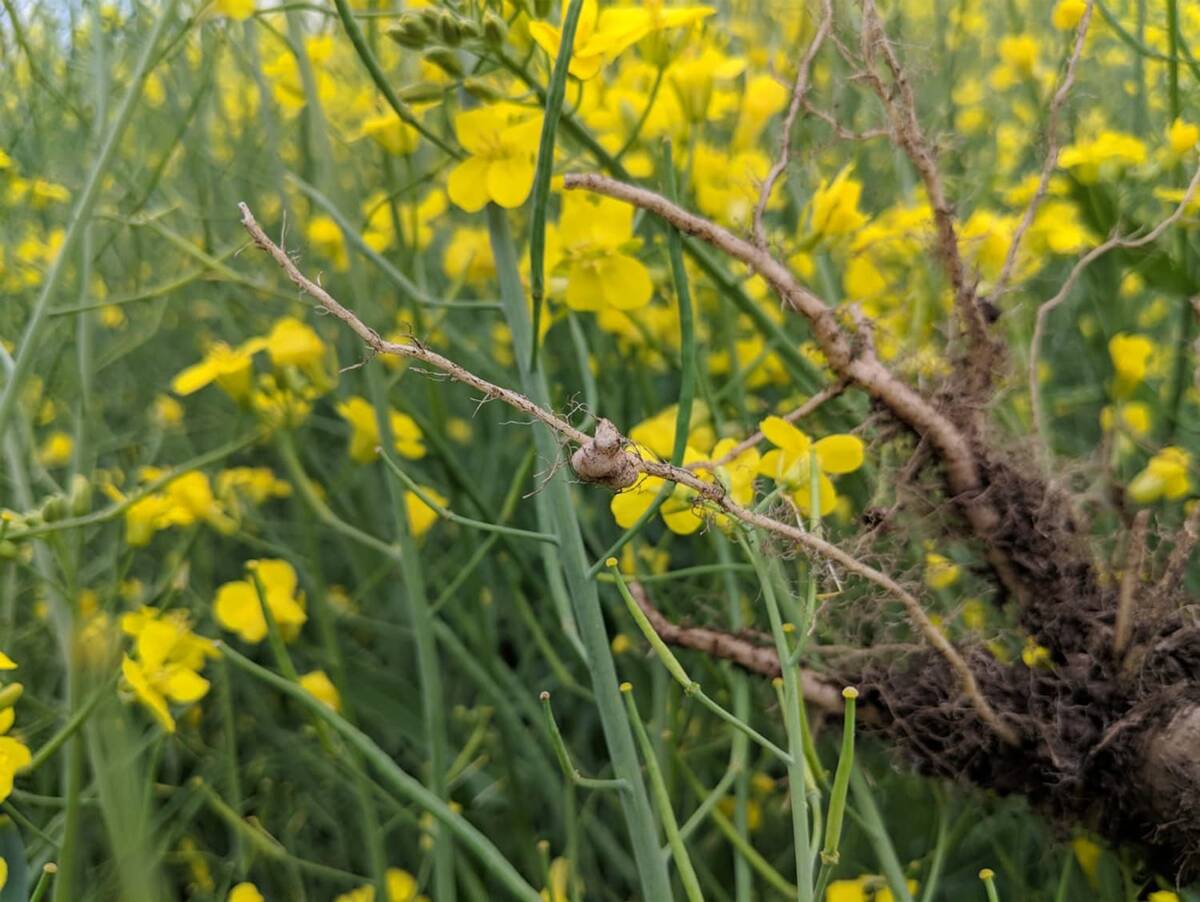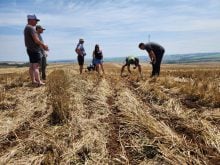The story of winter wheat on the Canadian Prairies is really the story of plant breeder Brian Fowler. Fowler entered the prairie winter wheat scene when he was designated head of that program at the University of Saskatchewan’s Crop Development Centre upon its opening in 1971.
Winter wheat was virtually unknown at that time, with the exception of southern Alberta. This year, snow is blanketing 1.245 million acres of winter wheat on the Prairies.
The crop has ranged from 500,000 to 1.37 million acres in recent years, depending on weather, soil moisture and markets.
Read Also

Going beyond “Resistant” on crop seed labels
Variety resistance is getting more specific on crop disease pathogens, but that information must be conveyed in a way that actually helps producers make rotation decisions.
The expansion is largely due to 15 winter wheat varieties that Fowler has released in his career. In many years, his CDC varieties accounted for 95 percent of all winter wheat acres on the Prairies.
However, those numbers don’t reflect Fowler’s true contribution to agriculture, said Lee Moats, a farmer from Riceton Sask., who was also a Ducks Unlimited agrologist for 28 years. Moats worked closely with Fowler on many joint winter wheat initiatives.
“In one word, his major contribution is knowledge.”
He also said Fowler was a key player in developing the zero till production system that farmers use today.
“Fowler was the first person to figure out that the only way you can grow winter wheat in our cold prairie environment is to stubble it in to trap an insulating layer of snow.”
He said Fowler demonstrated to growers that winter wheat management is significantly different than spring wheat.
The crop can exceed 100 bushels per acre in many prairie regions with correct agronomic practices and a small amount of luck from Mother Nature. However, it can be a bust without the right management.
Moats said it’s all about following the recommendations developed by Fowler over 40 years.
Farmers gradually caught onto the fact that winter wheat makes better use of soil moisture as well as time and equipment. Higher yielding genetics can result in yields 25 percent higher than spring wheat.
Those efficiency factors, coupled with the potential for big yields and high profits, have prompted more farmers to seed winter wheat when conditions are right.
However, Fowler said the road to acceptance was a rocky one for winter wheat. It takes 10 to 12 years to bring a new cultivar from early breeding through to registration.
“In the first 15 years, there wasn’t as much competition for funding, so we had time to get the breeding program up and running,” he said.
“But then it became a cat and dog battle to keep funding in place. Our whole winter wheat program here in Saskatchewan would have disappeared by the early ’90s if it hadn’t been for Ducks Unlimited.”
Beginning in the mid-1980s, Fowler battled every budget year to defend the program and continue the breeding and development of management practices.
“His breeding program was in jeopardy, mainly because of unrealized potential. Winter wheat is one of those crops where people thought the big breakthrough was just around the corner,” Moats said.
“But it never materialized in one giant step like that. It was a lot of little steps. And then we were hit with two consecutive years of one-in-50 environmental conditions.”
Growers who seeded winter wheat without following Fowler’s recommendations had the crop explode in their faces in 1985 with severe winterkill and again the following year with rust. Enthusiasm for winter wheat died along with the plants.
The setback was especially damaging because more than a million acres had been seeded to winter wheat in 1985 and 1986. By 1987, the crop nearly fell off the charts. There were two strikes against winter wheat, and Fowler’s program was near to striking out.
Proponents of other crops wanted to see the winter wheat program end so that those funds could go into their programs.
“Unfortunately, we had some very closed-minded people at the time controlling the strategic funds and grants at Saskatchewan Agriculture,” Moats said. “They turned the table badly on Brian.”
There were also problems with the CWB and its strict adherence to its kernel visual distinguishability requirements.
“I never did follow the logic behind KVD, but it did cause a lot of problems when it came to registration of winter wheat varieties,” Fowler said.
“I have similar problems when it comes to the General Purpose class. Farmers in the U.S.A. grow GP cultivars from my program for the human food market, but Canadian farmers can only grow them for feed and fuel, a limitation that continues in our current system.”
Two years of crop failure along with bureaucratic pressures nearly put an end to the crop.
Just when it seemed it was all over, a white knight intervened in the form of a federal-provincial program called the Economic Regional Development Agreement. This time fortune was on Fowler’s side.
He received a $1 million grant for agronomic research to continue his winter wheat program.
By using the funding to leverage other funds, he was able to keep the program alive until the early 1990s. The money gave him the resources to delve into aspects of winter wheat that he had not previously been able to explore.
“Not many people know this, but the information that came out of that $1 million grant is the genesis for all the material we use today in winter wheat agronomy,” he said.
Moats said Fowler’s program has had a side benefit that few people understand.
Highly competent researchers are needed to run research programs.
“And that spells graduate students. Go through a list of the most accomplished agronomists in Western Canada and you’ll see a lot of people who did their graduate studies and post doctorate work under Brian Fowler’s program. That in itself has been a major contribution to agriculture.”
However, the crunch was on again in 1991. Although Fowler earned registration for his first agronomically superior variety, CDC Kestral, that year, it was also the year the CDC board pulled the plug on his program.
Fowler held a strong personal belief that winter wheat had major agronomic and environmental benefits for prairie farmers, but without funding, the program was dead. Bureaucracy turned out to be a bigger threat to winter wheat than rust or winterkill.
Then, in 1992, another white knight appeared. Ducks Unlimited was looking for a way to cover large tracts of the prairie landscape with protective vegetation that would serve as nesting habitat in the spring when ducks arrive.
Winter wheat met the requirement. It’s sown in the fall and begins growing before winter arrives. The crop then pops back to life when the snow melts in the spring. By the time the ducks arrive, they see broad expanses of standing wheat plants where they nest with a better chance of hiding from predators.
Fowler explained to Ducks Unlimited that it could never coax farmers to grow winter wheat unless it was a proven profitable crop. To demonstrate that that was the case, they launched a program called Conserve and Win.
It was an agricultural extension program with a public relations twist and a few financial incentives.
Conserve and Win organized and packaged all the research and recommendations Fowler had developed over the years. The program ran from 1992 to 2000, reaching farmers who had never considered growing winter wheat.
The Winter Wheat Production Manual was the backbone of Conserve and Win. Fowler compiled the 15 chapter book based on research that he and collaborating scientists and their students had conducted since the early 1970s.
Formatted as a three ring binder, the manual walks farmers through the intricacies and challenges in every step of winter wheat production. More than 5,000 copies of the manual are in circulation.
It is considered the definitive word on growing winter wheat, and manuals have been ordered by growers in Europe, Syria, South America and across North America.
Fowler, working in conjunction with farmers and Ducks Unlimited agronomists, helped establish the Saskatchewan Winter Cereal Growers Association in 1994. Five years later, that organization evolved into Winter Cereals Canada.
Fowler and the association lobbied the federal government to remove bureaucratic obstacles that prevented winter wheat expansion. The government listened.
The final regulatory obstacle to fall was the requirement that winter wheat kernels be visually distinct from spring wheat kernels. This regulation had already prevented many high yielding winter wheat varieties from receiving registration.
“In 2000, the Agricultural Development Fund and the province of Saskatchewan decided to pull the remaining funding for the program. There’s strong competition for research funds, and they wanted to expand the pulse crop program,” Fowler said.
“That was frustrating because at the time, 95 percent of the winter wheat acres were seeded to CDC varieties. We had a mature program with a lot of promising plant material. It was just starting to get back on its feet.
“And once again it was DU that stepped in with enough money that we could wind down the program gradually instead of just stopping cold. I’d always use their money to leverage more money out of other sources.”
Fowler’s winter wheat program is now in the final stage of gradual closure. Work has continued on some of the best cultivars, and he expects two of them will be ready for release soon. Following their release, there will be no future CDC winter wheat varieties.
Fowler is philosophical about having his 40 year program shut down. He said having four winter wheat development programs on the Prairies may have been too rich.
“Maybe we were stretching the funding too thin with four programs. It might be better to have three well-funded programs.”
Although Conserve and Win ended in 2000, Fowler continued working with winter wheat. People beyond the farming community began to see the benefits of winter wheat in the larger picture.
In 2009, Bayer Crop Sciences committed $20 million over five years so Ducks Unlimited can continue its winter wheat involvement. The goal is to see two million acres of sustainable winter wheat on the Prairies by 2014.
With his component of the winter wheat program gone, Fowler is now focusing full-time research attention on cold tolerance in cereals, an area he has pursued for decades.
Winter wheat won’t survive if seeded into pulse stubble or summerfallow because not enough snow is trapped. Cracking the cold tolerance genetic code would remove the necessity of snow cover for winter survival.
That in turn would potentially open up millions of new winter wheat acres, give producers more flexibility in their rotations and lower risk.
Fowler also continues to serve as a professor in the U of S’s crop sciences department.

















